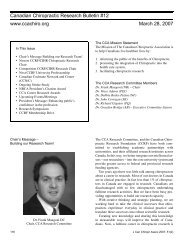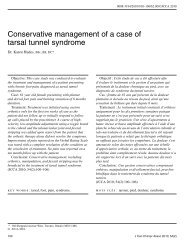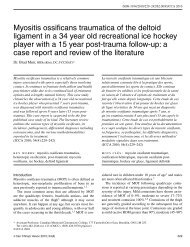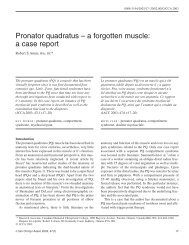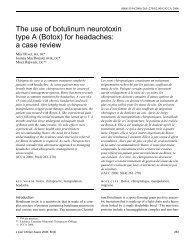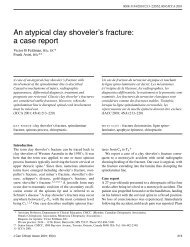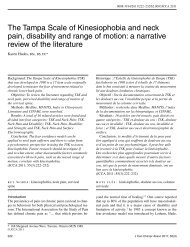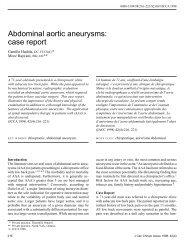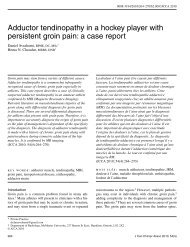Perceived effects of the delisting of chiropractic services from the ...
Perceived effects of the delisting of chiropractic services from the ...
Perceived effects of the delisting of chiropractic services from the ...
- No tags were found...
Create successful ePaper yourself
Turn your PDF publications into a flip-book with our unique Google optimized e-Paper software.
M Longo, M Grabowski, B Gleberzon, J Chappus, C JakymTable 1 Predicted negative consequences <strong>of</strong> OHIP<strong>delisting</strong> to chiropractors and <strong>the</strong>ir patients 8,9• Decrease access to chiropractors due to escalationin costs per visit• Decrease in quality <strong>of</strong> care to patients• Longer wait times to receive care• Less cost-effect care provided to patients• Less appropriate care provided to patients• Increased costs to <strong>the</strong> MOHLTC• Increase in expenditures on prescription drugs• Increase in emergency room visits• Directional shift away <strong>from</strong> governments transformationand integration agenda• Marginalization <strong>of</strong> <strong>the</strong> <strong>chiropractic</strong> pr<strong>of</strong>essionticipants were recruited <strong>from</strong> Toronto via <strong>the</strong> College <strong>of</strong>Chiropractors <strong>of</strong> Ontario (CCO) online directory on October21, 2009 [all practicing chiropractors in Ontario mustbe registered (or licenced) with CCO]. The 591 practicingchiropractors in Toronto were assigned a number; <strong>the</strong>numbers were randomized to reduce sampling bias bystatistical s<strong>of</strong>tware listed as R project 10 and <strong>the</strong> first 199chiropractors selected were used in <strong>the</strong> study. Since <strong>the</strong>sampling frame includes all practicing chiropractors in <strong>the</strong>GTA (population <strong>of</strong> interest), a randomly chosen group isconsidered to be highly representative. Chiropractors notin Toronto or not registered with <strong>the</strong> CCO were excluded<strong>from</strong> this study. Since not all selected chiropractors hademail, it was decided that surveys would be distributedby ground mail. Also, it was posited that mailing out <strong>the</strong>survey as opposed to an interview would be more efficientboth in terms <strong>of</strong> time and cost.The surveys were mailed to 199 chiropractors onOctober 28, 2009 and were received up until December18, 2009. Data was collected and analyzed January 26,2010. The choice <strong>of</strong> sample sized was taken such that 95%confidence intervals around proportions <strong>of</strong> interest wouldbe sufficiently narrow. Based on <strong>the</strong> estimate <strong>of</strong> a 60% responserate we believed we would get 120 people. 11 Thiswould ensure that any CI around a proportion with samplesize around 120 would yield a confidence interval nowider <strong>the</strong>n 18 percentage points. Surveys were coded anda second survey was re-sent on April 19, 2010 to thosechiropractors who had not responded initially. The secondset <strong>of</strong> surveys were accepted until June 1, 2010. Data wascollected <strong>from</strong> this second step and was analyzed June 8,2010.ConfidentialityEach <strong>of</strong> <strong>the</strong> participant’s records were stored on a passwordprotected computer and any paper work was lockedin a filing cabinet and <strong>the</strong>n shredded subsequent to dataacquisition in order to protect <strong>the</strong> privacy <strong>of</strong> <strong>the</strong> individuals.Respondents were not required to identify <strong>the</strong>mselvesany where on <strong>the</strong> survey.DeceptionNo deception was used in this study.Survey instrumentThe survey questions were developed during a series <strong>of</strong>discussion among <strong>the</strong> research team. Since, to <strong>the</strong> best<strong>of</strong> our knowledge, this is <strong>the</strong> first survey <strong>of</strong> its kind, aunique set <strong>of</strong> questions were developed that <strong>the</strong> authors’believed would best capture <strong>the</strong> data <strong>the</strong>y sought to ga<strong>the</strong>r(see Appendix). Thus, <strong>the</strong> survey had a degree <strong>of</strong> facevalidity but was not pre-tested. The study participantswere asked to disclose <strong>the</strong>ir age, sex, length <strong>of</strong> time inpractice, if <strong>the</strong>y were in practice at <strong>the</strong> time when OHIPcoverage was in effect, if <strong>the</strong>y perceived OHIP <strong>delisting</strong>affected <strong>the</strong>ir patient volume and practice income and, ifso, whe<strong>the</strong>r or not <strong>the</strong>y perceived <strong>the</strong>ir patient volume hadsubsequently recovered during <strong>the</strong> intervening years. Theparticipants were also asked if <strong>the</strong>y perceived that OHIP<strong>delisting</strong> negatively impacted <strong>the</strong> credibility <strong>of</strong> <strong>the</strong> pr<strong>of</strong>ession.Lastly, survey participants were asked if <strong>the</strong>y wouldbe in favor <strong>of</strong> OHIP coverage being reinstated and, if so,to what extent and for whom.Statistical AnalysisPercentages were calculated <strong>from</strong> <strong>the</strong> data and are presentedin Table form along with raw numbers. A twosided test <strong>of</strong> differences between proportions was used tocompare results. 10 An alpha level <strong>of</strong> 0.05 was used as <strong>the</strong>standard for statistical significance. Due to <strong>the</strong> nature <strong>of</strong>each variable being dichotomous a chi squared test is warranted.This test is also representative <strong>of</strong> a test <strong>of</strong> differencein proportions. Data were coded into a spread sheet.R project statistical s<strong>of</strong>tware was used in <strong>the</strong> randomizationprocess. 10J Can Chiropr Assoc 2011; 55(3) 195
<strong>Perceived</strong> <strong>effects</strong> <strong>of</strong> <strong>the</strong> <strong>delisting</strong> <strong>of</strong> <strong>chiropractic</strong> <strong>services</strong> <strong>from</strong> <strong>the</strong> Ontario Health Insurance Plan on practice activitiesTable 2 Number <strong>of</strong> years in practice amongrespondents (n = 123)Years inpracticePercent (n)95% ConfidenceInterval0–5 25.2% (32) (17.5, 32.9)6–10 30.1% (37) (22.0,38.2)11–15 13.8% (17) (7.7, 19.9)16–20 8.9% (11) (3.9, 13.9)21–25 4.1% (5) (0.6,7.6)26–30 6.5% (8) (2.1,10.9)31–35 10.6% (13) (5.2,16.0)>36 0.8% (1) (0.0,2.4)Table 3 <strong>Perceived</strong> percentages <strong>of</strong> income lost amongthose chiropractors in practice during OHIP coveragesubsequent to its <strong>delisting</strong> (n = 52)Percentages <strong>of</strong>income lost (%)Percent (n)95%ConfidenceInterval0–10 30.8% (16) (18.3, 43.3)11–20 32.7% (17) (19.9, 45.5)21–30 23.1% (12) (7.6, 38.6)31–40 5.8% (3) (0.0, 12.2)41–50 3.8% (2) (1.4, 9.0)>50 3.8% (2) (0.0, 9.0)ResultsResponse rate and number <strong>of</strong> years in practiceOf <strong>the</strong> 199 OHIP surveys mailed out, 123 chiropractorsresponded to <strong>the</strong> questionnaire representing a responserate <strong>of</strong> 61.8%. Six surveys were returned to sender. Thisnumber <strong>of</strong> respondents provided a reasonably large proportion<strong>of</strong> <strong>the</strong> entire population <strong>of</strong> interest (chiropractorsin <strong>the</strong> GTA) and thus was thought to be representative <strong>of</strong>this population with respect to age, gender and number <strong>of</strong>years in practice. Of <strong>the</strong> chiropractors who responded, <strong>the</strong>number <strong>of</strong> years in practice ranged <strong>from</strong> 1 to 52 with <strong>the</strong>average being 13.5 years (SD = 10.4) (see Table 2).Perception <strong>of</strong> <strong>the</strong> Effect <strong>of</strong> OHIP <strong>delisting</strong> onChiropractors’ Practice IncomeChiropractors were asked to respond whe<strong>the</strong>r or not <strong>the</strong>yperceived <strong>the</strong> <strong>delisting</strong> <strong>of</strong> OHIP in 2004 initially affected<strong>the</strong>ir businesses financially. Forty-five respondents reportedthat <strong>the</strong>ir practice was negatively affected (36.6%)[95% CI: (0.281,0.451)], 47 reported <strong>the</strong>ir practice wasnot affected (38.2%) [95% CI: (0.296,0.468)], and 31(25.2%) [95% CI: (0.175,0.329)] were not in practiceat <strong>the</strong> time <strong>of</strong> OHIP coverage; <strong>the</strong>refore, this questionwas not applicable to <strong>the</strong>m. (NB: Seven chiropractorsstated that <strong>the</strong>ir business was not effected, but circled a“0–10%”decline in practice income. This is explainedfur<strong>the</strong>r in <strong>the</strong> “study’s limitations” section below). Thus,<strong>of</strong> <strong>the</strong> 92 chiropractors in practice at <strong>the</strong> time <strong>of</strong> OHIPcoverage, 48.9% [95% CI: (0.387,0.591)] reported <strong>the</strong>irpractice was negatively affected and 51.2% [95% CI:(0.410,0.614)] reported it was not.With respect to those chiropractors who reported that<strong>the</strong>ir practice incomes declined due to OHIP <strong>delisting</strong> (n =52), roughly a third reported <strong>the</strong>y perceived <strong>the</strong>ir practicerevenues declined by less than 10% , a third reported <strong>the</strong>yperceived <strong>the</strong>ir practice income declined between 11%and 20%, and <strong>the</strong> remaining third perceived <strong>the</strong>ir practicerevenue dropped more than 20% (see Table 3).Perception <strong>of</strong> <strong>the</strong> effect <strong>of</strong> OHIP <strong>delisting</strong> onchiropractors’ patient volumeRespondents were asked whe<strong>the</strong>r or not <strong>the</strong> <strong>delisting</strong><strong>of</strong> OHIP resulted in a decrease <strong>of</strong> <strong>the</strong>ir patient population(or volume) immediately after <strong>delisting</strong>. Forty-fivechiropractors (36.6%) [95% CI: (0.225,0.507)] said<strong>the</strong>ir patient population decreased, 52 (42.3%) [95% CI:(0.225,0.507)] said <strong>the</strong>ir patient population did not decrease,and 26 (21.1%) [95% CI: (0.092,0.330)] were notin practice at <strong>the</strong> time <strong>of</strong> OHIP coverage <strong>the</strong>refore, thisquestion was not applicable.Of <strong>the</strong> respondents who reported a decline in patientpopulations attributed to OHIP <strong>delisting</strong> (n = 45), 12196 J Can Chiropr Assoc 2011; 55(3)
M Longo, M Grabowski, B Gleberzon, J Chappus, C JakymTable 4 <strong>Perceived</strong> decline in patient volumeimmediately after <strong>the</strong> <strong>delisting</strong> <strong>of</strong> OHIP (n = 45)Percentage <strong>of</strong>patients lost(%) Percent (n)95%ConfidenceInterval0–10 26.7% (12) (13.8, 39.6)11–20 40% (18) (25.7, 54.3)21–30 22.2% (10) (10.1 34.3)31–40 8.9% (4) (0.6,0.17.2)41–50 2.2% (1) (0.0, 6.5)>50 0(26.7%) [95% CI: (0.138,0.396)] reported a decline <strong>of</strong>0–10%, 18 (40.0%) [95% CI: (0.257,0.543)] reporteda decline <strong>of</strong> between 11–20%, 10 (22.2%) [95% CI:(0.101,0.343)] reported a decline between 21–30% and5 (11.1%) [95% CI: (0.019,0.203)] reported a decline <strong>of</strong>over 31% <strong>of</strong> <strong>the</strong>ir patient base (see Table 4).Those chiropractors who said that <strong>the</strong>ir patient volumedecreased immediately after <strong>delisting</strong> <strong>of</strong> OHIP were askedto state whe<strong>the</strong>r or not <strong>the</strong>ir patient population has sincerecovered. Only 40 <strong>of</strong> <strong>the</strong> 45 chiropractors who reporteda decline in patient volume responded to this question. Of<strong>the</strong>se 40 respondents, 12 (30.0%) [95% CI: (0.158,0.442)]reported that <strong>the</strong>ir patient population recovered and ishigher than before <strong>the</strong> <strong>delisting</strong>, 11 (27.5%) [95% CI:(0.137,0.413)] that <strong>the</strong>ir patient population has recoveredand it is equal to what it was before and 17 (42.5%) [95%CI: (0.349,0.501)] reported that <strong>the</strong>ir patient populationhas not recovered (Table 5).Table 5 Whe<strong>the</strong>r or not <strong>the</strong> patient population/volumehas recovered among those chiropractors who perceived<strong>the</strong>ir patient population immediately decreased after <strong>the</strong><strong>delisting</strong> <strong>of</strong> OHIP coverage (n = 40)Effects on patientpopulationPercent (n)95%ConfidenceIntervalPatient populationrecovered and higherthan before 30% (12) (15.8,0.44.2)Patient populationrecovered and is equalto before 27% (11) (13.7,41.3)Patient population hasnot recovered 42.5%(17) (34.9,50.1)<strong>Perceived</strong> effect <strong>of</strong> OHIP <strong>delisting</strong> on <strong>the</strong>pr<strong>of</strong>ession’s credibilityChiropractors were asked if <strong>the</strong>y thought that losing OHIPcoverage detracted <strong>from</strong> <strong>the</strong> credibility <strong>of</strong> <strong>the</strong> pr<strong>of</strong>ession.One hundred and twenty two chiropractors responded tothis question. Sixty-four (52.5%) [95% CI: (0.436,0.614)]reported that OHIP <strong>delisting</strong> detracted <strong>from</strong> <strong>the</strong> credibility<strong>of</strong> <strong>the</strong> pr<strong>of</strong>ession, while 58 (47.5%) [95% CI:(0.386,0.564)] said that it did not. However, <strong>of</strong> <strong>the</strong> 29chiropractors who were not in practice under OHIP coveragewho responded to this question, 17 (58.6%) [95% CI:(0.407,0.765) felt that losing OHIP took away <strong>from</strong> <strong>the</strong>credibility <strong>of</strong> <strong>the</strong> pr<strong>of</strong>ession. Of <strong>the</strong> 93 chiropractors whowere in practice under OHIP coverage and responded tothis question, 47 (50.5%) [95% CI: (0.403,0.607)] believedthat losing OHIP detracted <strong>from</strong> <strong>the</strong> credibility<strong>of</strong> <strong>the</strong> pr<strong>of</strong>ession as compared to 45 (49.5%) [95% CI:(0.393,0.597)] who did not (x 2 = 0.58, df = 1, p = 0.447,p = 0.45). There was no statistical significance between<strong>the</strong>se two groups (Figure 2).Perception <strong>of</strong> whe<strong>the</strong>r or not OHIP should bereinstated for <strong>chiropractic</strong> <strong>services</strong>Chiropractors were surveyed as to <strong>the</strong>ir desire for OHIPcoverage to be reinstated. One hundred and fifteen respondentsaddressed this question. Of <strong>the</strong>se 115 respondents,53 (46.1%) [95% CI: (0.370,0.552)] were in favor <strong>of</strong>OHIP coverage reinstatement as compared to 62 (53.9%)[95% CI: (0.448,0.630)] who were not. Of <strong>the</strong> 28 chiropractorsthat were not in practice under OHIP coverage,19 (67.9%) [95% CI: (0.846,0.846)] wanted OHIPreinstated compared to 34 <strong>of</strong> <strong>the</strong> 87 (39.1%) [95% CI:(0.288,0.494)] chiropractors who were in practice underOHIP coverage (x 2 = 7.06, df = 1, p = 0.001). There wasa statistical significance between <strong>the</strong>se two groups (seeFigure 2)J Can Chiropr Assoc 2011; 55(3) 197
<strong>Perceived</strong> <strong>effects</strong> <strong>of</strong> <strong>the</strong> <strong>delisting</strong> <strong>of</strong> <strong>chiropractic</strong> <strong>services</strong> <strong>from</strong> <strong>the</strong> Ontario Health Insurance Plan on practice activitiesFigure 1 A comparison between chiropractors whohad and had not experienced OHIP coverage and if <strong>the</strong><strong>delisting</strong> <strong>of</strong> OHIP took away <strong>from</strong> <strong>the</strong> credibility <strong>of</strong> <strong>the</strong>pr<strong>of</strong>ession.Perception <strong>of</strong> amount OHIP should pay for<strong>chiropractic</strong> <strong>services</strong> if it were to be reinstated andwho should be eligibleOf <strong>the</strong> respondents who wanted OHIP coverage reinstated(n = 53, roughly half <strong>of</strong> whom were not inpractice under OHIP coverage), 43 (91.5%) [95% CI:(0.840,0.990)] wanted greater than <strong>the</strong> prior coverage<strong>of</strong> $9.65 for <strong>the</strong> general population, 2 <strong>of</strong> <strong>the</strong> 47 (4.3%)[95% CI: (–0.012,0.098)] respondents wanted <strong>the</strong> samecoverage ($9.95) and 2 <strong>of</strong> <strong>the</strong> 47 (4.25%) (4.3%) [95%CI: (–0.012,0.098)] respondents wanted less coveragethan prior to <strong>the</strong> <strong>delisting</strong> (
M Longo, M Grabowski, B Gleberzon, J Chappus, C Jakymat Schedule 5 clinics due to a low payment structure perclient visit, forcing facilities to provide less care in orderto maintain <strong>the</strong>ir pr<strong>of</strong>itability. Lastly, Gordon et al 12 notedthat, within <strong>the</strong> European literature, <strong>the</strong>re was a significantreduction in <strong>the</strong> use <strong>of</strong> essential medication by patientswhen <strong>the</strong>y had to co-pay (ra<strong>the</strong>r than receive <strong>the</strong>irmedications at no cost) and that <strong>the</strong> effect <strong>of</strong> <strong>delisting</strong> <strong>of</strong>PT <strong>services</strong> in o<strong>the</strong>r provinces, notably British Columbia,resulted in “increased waiting time, a 28% decrease inpatients accessing community-based care and reports <strong>of</strong>patients ending treatment prematurely.” 13;p166Landry et al 3 reported on any changes among PT clientsbefore and after <strong>delisting</strong> with respect to access to<strong>services</strong> and self-reported health (SRH) status. Also usinga telephone questionnaire design, <strong>the</strong>se researchers reportedthat after partial <strong>delisting</strong> <strong>of</strong> PT <strong>services</strong>, 81 <strong>of</strong> 113(71.7%) participants who required <strong>services</strong> continued toreceive <strong>the</strong>m; among this group, roughly half (50.6%) remainedeligible for OHIP, indicating <strong>the</strong> remainder <strong>of</strong> <strong>the</strong>clients were willing to assume <strong>the</strong> cost <strong>of</strong> care <strong>the</strong>mselves(that said, <strong>the</strong> researchers reported that one-third <strong>of</strong> clientswere able to continue with care because <strong>the</strong>y had privateinsurance coverage for it). Perhaps more importantly, accessafter <strong>delisting</strong> was statistically associated with goodhealth. Specifically, participants who required PT <strong>services</strong>and received <strong>the</strong>m after <strong>delisting</strong> were more than 10 timesas likely to report good health compared to clients whorequired but did not receive <strong>services</strong>. 3In a study that sought to monitor <strong>the</strong> effect <strong>of</strong> <strong>the</strong> partial<strong>delisting</strong> <strong>of</strong> PT <strong>services</strong> on both clients and providers12 months after its implementation, Paul et al 4 reportedthat clients rendered ineligible for OHIP coverage continuedto experience barriers to access <strong>of</strong> <strong>services</strong> acrossOntario, most due to <strong>the</strong> inability or unwillingness to payout-<strong>of</strong>-pocket for <strong>services</strong>. Also, clients in this study expressed<strong>the</strong>ir concern with respect to <strong>the</strong>ir health statusand reported increased use <strong>of</strong> o<strong>the</strong>r health pr<strong>of</strong>essionals(principally physicians) and <strong>services</strong> (i.e. hospitals).These authors also reported that DPC providers had experienceda drop in clinic volumes <strong>from</strong> between 18% to50%. Similar to <strong>the</strong> study by Landry et al described above,<strong>the</strong> researchers <strong>of</strong> this study reported that both PTs and<strong>the</strong>ir clients perceived <strong>delisting</strong> had had a detrimental effecton <strong>the</strong>ir health status. These findings led Paul et al toconclude: “On <strong>the</strong> basis <strong>of</strong> our study <strong>of</strong> <strong>the</strong> perceptions <strong>of</strong>clients and providers, we believe that health outcomes forindividuals no longer eligible for PT <strong>services</strong> and thosewho choose to forgo PT entirely may be negatively impactedby <strong>delisting</strong> policies such as <strong>the</strong> one implementedby Ontario.” 4p338 That said, <strong>the</strong> authors also noted thatsome PT providers did view <strong>delisting</strong> <strong>of</strong> <strong>services</strong> <strong>from</strong>publicly-funded government plans as potentially advantageousin terms <strong>of</strong> financial pr<strong>of</strong>itability since clients arepaying for <strong>services</strong> out-<strong>of</strong>-pocket at a much higher unitprice than received by provincial pubic payors. In o<strong>the</strong>rwords, <strong>the</strong>se authors, as well as Landry et al speculatedthat <strong>the</strong> only PTs and clients who were burdened by <strong>delisting</strong>were DPCs and some home care providers. 4Similar studies have been published on <strong>the</strong> forecasted<strong>effects</strong> <strong>of</strong> <strong>the</strong> delising <strong>of</strong> <strong>chiropractic</strong> <strong>services</strong> in Ontario.Deloitte, a consulting service, was hired by <strong>the</strong> OntarioChiropractic Association (OCA) to conduct a review <strong>of</strong><strong>the</strong> potential consequences <strong>of</strong> OHIP <strong>delisting</strong> in 2004. 9Deloitte, as well as o<strong>the</strong>rs, have reported that musculoskeletal(MSK) disorders are among <strong>the</strong> most costly anddisabling disorder to <strong>the</strong> health care system and <strong>of</strong> <strong>the</strong>1.2 million Ontarians who visit chiropractors a year do s<strong>of</strong>or MSK conditions. 9 It was predicted that <strong>the</strong> <strong>delisting</strong><strong>of</strong> OHIP coverage for chiropractors and o<strong>the</strong>r health careproviders would result in savings by <strong>the</strong> provincial government<strong>of</strong> $200 million dollars over a two year period. 8,9However, <strong>the</strong>se expected cost savings may not have accountedfor <strong>the</strong> increased cost caused by <strong>the</strong> transfer <strong>of</strong>patients with MSK problems <strong>from</strong> chiropractors to o<strong>the</strong>rhealth care providers, principally medical doctors or visitsto emergency rooms (ERs). 8,9 In support <strong>of</strong> this concern,Deloitte reported that a recent poll indicated that, amongOntarians who had seen a chiropractor in <strong>the</strong> previousyear, more than half (54%) indicated that <strong>delisting</strong> woulddiscourage <strong>the</strong>m <strong>from</strong> continuing to seek out <strong>chiropractic</strong>care and would, instead, seek out care <strong>from</strong> familyphysicians or emergency departments. 9 Since OHIP paidapproximately $10 per <strong>chiropractic</strong> visit, whereas OHIPpaid roughly $30 per physician visit, <strong>the</strong> cost <strong>of</strong> a medicalconsultation would be at least three times higher than a<strong>chiropractic</strong> consultation, and this cost does not includeo<strong>the</strong>r costs such as prescription drugs, laboratory or o<strong>the</strong>rdiagnostic testing. Moreover, <strong>the</strong> average visit to an emergencyroom is estimated to be between $125 and $143, oran order <strong>of</strong> magnitude higher than <strong>the</strong> fee for a <strong>chiropractic</strong>service.In addition to concerns above escalating costs to <strong>the</strong>J Can Chiropr Assoc 2011; 55(3) 199
<strong>Perceived</strong> <strong>effects</strong> <strong>of</strong> <strong>the</strong> <strong>delisting</strong> <strong>of</strong> <strong>chiropractic</strong> <strong>services</strong> <strong>from</strong> <strong>the</strong> Ontario Health Insurance Plan on practice activitieshealth care delivery system, Deloitte also raised concernswith respect to quality <strong>of</strong> care (in terms <strong>of</strong> prolonged waittime), effectiveness and appropriateness <strong>of</strong> care, availability<strong>of</strong> providers (<strong>the</strong>re is a chronic shortage <strong>of</strong> familyphysicians in Ontario), cost-effectiveness <strong>of</strong> care (<strong>chiropractic</strong>care if <strong>of</strong>ten shown to be more cost-effective thano<strong>the</strong>r forms <strong>of</strong> <strong>the</strong>rapy for MSK conditions such as lowback and neck pain), patient satisfaction (<strong>chiropractic</strong>patients typically report <strong>the</strong>y are very satisfied with <strong>the</strong>care <strong>the</strong>y receive) and alignment with government priorities.9 Manga 8 raised similar concerns and calculated thatalthough <strong>the</strong> Ontario government would save $100 millionannually by not paying for <strong>chiropractic</strong> <strong>services</strong> <strong>the</strong>ywould incur at least $200 million in additional health careexpenditures as patients shift <strong>from</strong> chiropractors to morecostly provincially funded health care <strong>services</strong>. Mangaalso voiced his concern that <strong>the</strong> <strong>delisting</strong> <strong>of</strong> <strong>chiropractic</strong><strong>services</strong> would marginalize <strong>the</strong> pr<strong>of</strong>ession <strong>from</strong> <strong>the</strong> healthcare sector in Ontario. 8A few years after <strong>the</strong> <strong>delisting</strong> <strong>of</strong> <strong>services</strong>, <strong>the</strong> OCAsurveyed its members to ascertain if <strong>the</strong>ir patient numbersand <strong>the</strong> fees charged to <strong>the</strong>se patients changed as a consequence<strong>of</strong> it. 7 Data was collected during two week periods,one in September 2004 and <strong>the</strong> o<strong>the</strong>r in September2006. The results revealed that respondent chiropractorsincreased <strong>the</strong>ir fees by $3 in addition to <strong>the</strong> $9.65 whichwas once covered by OHIP. From 2004–2006, <strong>the</strong> overallnumber <strong>of</strong> patients seen by chiropractors decreased with<strong>the</strong> number <strong>of</strong> new <strong>chiropractic</strong> patients reportedly decliningby 22% and <strong>the</strong> average number <strong>of</strong> patients visits fell<strong>from</strong> 8.6 annually to 8.3. Conversely, it was reported thatpatients visiting chiropractors with extended insurancecoverage increased by 40% and patients claiming through<strong>the</strong> Workplace Safety and Insurance Board (WSIB) increasedby 44%. 7Our study found that many chiropractors reported a declinein <strong>the</strong>ir practice revenue around <strong>the</strong> time <strong>of</strong> <strong>delisting</strong>,which chiropractors in this study attributed to that event.However, <strong>the</strong>re may have been o<strong>the</strong>r factors effecting thispercieved decline in practice revenue, and it bears emphasizingthat we are not drawing a causal relationship betweenOHIP <strong>delisting</strong> and practice pattern changes basedon <strong>the</strong> data obtained in this study. Mior and Laporte 14reported that <strong>the</strong> number <strong>of</strong> chiropractors in Ontario ison <strong>the</strong> rise while <strong>the</strong> number <strong>of</strong> <strong>chiropractic</strong> patients hasremained unchanged, resulting in a decline in <strong>the</strong> net revenue<strong>of</strong> Ontarian chiropractors between 1993 and 2003.Mior and Laporte posited that <strong>the</strong>se demographic trends,combined with <strong>the</strong> loss <strong>of</strong> public funding through OHIP,may contribute fur<strong>the</strong>r to this declinig revenue <strong>of</strong> fieldpractitioners and create more challenges for <strong>the</strong>m in terms<strong>of</strong> economic sustainability. 14 In this study, some respondentsreported <strong>the</strong>y experienced a detrimental effect to both<strong>the</strong>ir patient volume and practice income as a result <strong>of</strong> <strong>the</strong>OHIP <strong>delisting</strong>, at least initially. However, almost twothirds<strong>of</strong> chiropractors surveyed indicated that <strong>the</strong>ir patientvolume and practice revenues are now <strong>the</strong> same orgreater than <strong>the</strong>y were at <strong>the</strong> time <strong>of</strong> OHIP <strong>delisting</strong>.Although it appears that having <strong>chiropractic</strong> coveredunder OHIP would benefit <strong>the</strong> provincial health care systemand practicing chiropractors alike, <strong>the</strong> results <strong>of</strong> ourstudy indicate that most chiropractors in Toronto do notwant OHIP coverage reinstated, a finding most evidentamong those chiropractors who were in practice during<strong>the</strong> time OHIP partially covered <strong>chiropractic</strong> <strong>services</strong>.There was statistical significance between those chiropractorswho were in practice under OHIP as comparedto those chiropractors who were not in terms <strong>of</strong> <strong>the</strong>ir desireto have OHIP coverage reinstated. Specifically, thosechiropractors who were in practice during OHIP coveragewere much less favorably inclined to have OHIP coveragereinstated. There are several possible explanations for thisobservation.For <strong>the</strong> chiropractor, <strong>the</strong> mechanization <strong>of</strong> OHIP paymentwas an arduous process (Gleberzon – personalcommunication). A practitioner would typically receivereimbursement 30 or 60 days after <strong>the</strong> date service wasrendered, provided <strong>the</strong> practitioner had <strong>the</strong> correct demographicinformation on <strong>the</strong>ir patient (date <strong>of</strong> birth, sex),that <strong>the</strong> patient informed <strong>the</strong>ir chiropractor <strong>of</strong> any changeto <strong>the</strong>ir Health Care Card Version Code and that <strong>the</strong> patientdid not exhaust <strong>the</strong>ir <strong>chiropractic</strong> OHIP coverage ina calendar year with ano<strong>the</strong>r chiropractor. In addition, fora period <strong>of</strong> time in <strong>the</strong> early 2000s, <strong>the</strong> Ontario governmentinstituted <strong>the</strong> “Social Contract” which reduced <strong>the</strong>amount reimbursed for a <strong>chiropractic</strong> service <strong>from</strong> $9.65to $8.44. In addition, <strong>the</strong>re was ano<strong>the</strong>r level <strong>of</strong> regulatoryoversight by <strong>the</strong> MOHLTC, which operated through<strong>the</strong> Chiropractic Review Committee via <strong>the</strong> College <strong>of</strong>Chiropractors <strong>of</strong> Ontario. It is noteworthy that, accordingto <strong>the</strong> OCA survey, patients who had private insurancecoverage for <strong>chiropractic</strong> care through <strong>the</strong>ir place <strong>of</strong>200 J Can Chiropr Assoc 2011; 55(3)
M Longo, M Grabowski, B Gleberzon, J Chappus, C Jakymemployment, did not feel <strong>the</strong> <strong>effects</strong> <strong>of</strong> OHIP <strong>delisting</strong>. 7This is because <strong>the</strong>se persons had to exhaust <strong>the</strong>ir OHIPcoverage prior to accessing <strong>the</strong>ir private insurance coverage,since insurance companies considered OHIP ano<strong>the</strong>rtype <strong>of</strong> insurance and would not co-pay while a patientwas eligible under OHIP. OHIP covered patients up to,initially, $220 a calendar year (beginning July 1), whichwas reduced to $150. Thus, it would require roughly 15visits for a patient to exhaust <strong>the</strong>ir OHIP coverage; however,few patients required that many treatments, and thusdid not exhause <strong>the</strong>ir OHIP coverage. However, in <strong>the</strong> absence<strong>of</strong> OHIP coverage, a patient could immediately bereimbursed for <strong>the</strong> total amount <strong>of</strong> a treatment if he orshe possessed a private insurance plan. To <strong>the</strong>se patients,OHIP’s <strong>delisting</strong> <strong>of</strong> <strong>chiropractic</strong> treatment would be <strong>of</strong> financialbenefit to <strong>the</strong>m.Over half <strong>of</strong> <strong>the</strong> respondents opined that losing OHIPtook away <strong>from</strong> <strong>the</strong> credibility <strong>of</strong> <strong>the</strong> <strong>chiropractic</strong> pr<strong>of</strong>ession.Almost 60% <strong>of</strong> <strong>the</strong> chiropractors who were not inpractice during OHIP coverage felt that <strong>delisting</strong> diminished<strong>the</strong> credibility <strong>of</strong> <strong>the</strong> pr<strong>of</strong>ession. By comparison,roughly half <strong>of</strong> <strong>the</strong> chiropractors who were in practiceduring OHIP coverage perceived that <strong>the</strong> credibility <strong>of</strong> <strong>the</strong>pr<strong>of</strong>ession was negatively affected by its <strong>delisting</strong>. Thedifferences between <strong>the</strong>se two groups were not statisticallysignificant. That said <strong>the</strong>re was a statistically significantdifference between those chiropractors who were inpractice during OHIP coverage compared to those chiropractorswho were not in terms <strong>of</strong> <strong>the</strong>ir desire for OHIPto be reinstated; specifically, <strong>the</strong> desire to have OHIP reinstatedis statistically higher among those chiropractorswho were not in practice when it was in effect. Amongthose chiropractors who do wish to be covered underOHIP again, <strong>the</strong> vast majority would only do so if <strong>the</strong>ywere paid more than <strong>the</strong> previous amount <strong>of</strong> $9.65 and<strong>the</strong>y would be in favor <strong>of</strong> coverage if it was extended towardsseniors, children and low-income persons.Study LimitationsThere were several limitations to this study. The surveyinstrument was developed by <strong>the</strong> research team and, althoughit had face validity, it was not pre-tested to determineits clarity and reliability among respondents.In constructing our survey, we assumed that <strong>the</strong> <strong>delisting</strong><strong>of</strong> OHIP would negatively affect chiropractorsboth in terms <strong>of</strong> patient numbers and practice revenuesand constructed our survey to reflect this hypo<strong>the</strong>sis. Thatis to say, we did not provide an option that would indicatea respondent experienced an increase in patient volume orrevenue immediately subsequent to <strong>delisting</strong>. In <strong>the</strong> commentsection <strong>of</strong> our survey a few chiropractors explainedthat <strong>the</strong>ir practice was positively affected financially andpatient numbers increased immediately following <strong>the</strong> <strong>delisting</strong><strong>of</strong> OHIP coverage. Also, because <strong>of</strong> <strong>the</strong> manner inwhich responses were grouped in our survey, if a chiropractorhad not suffered a loss <strong>of</strong> patients or revenue s/hewould have had to circle <strong>the</strong> “0–10% loss” option. Thesedesign flaws must be addressed in any subsequent version<strong>of</strong> this study. We instructed respondents who asserted that<strong>the</strong>ir patient population had declined immediately after<strong>delisting</strong> to indicate whe<strong>the</strong>r or not patient population(volume) had returned to pre-<strong>delisting</strong> levels; we chosenot to ask <strong>the</strong> same question with respect to patient incomesince we assumed that patient income would berelated to patient volume and a positive improvement inone would result in a positive improvement in <strong>the</strong> o<strong>the</strong>r.However, this did not take into account <strong>the</strong> possibility thata practitioner may have altered his or her practice activitiesto increase revenue by means o<strong>the</strong>r than patient visits(by <strong>of</strong>fering more <strong>services</strong> such as acupuncture, orthotics,rehabilitation or perhaps by refocusing on o<strong>the</strong>r practiceopportunities such as performing independent <strong>chiropractic</strong>examinations for third party payors such as insurancecompanies). This possibility ought to be addressed in subsequentstudiesThe survey was only mailed to chiropractors in Toronto.They may not be representative <strong>of</strong> all Ontarian chiropractorssince Toronto is a large, urban, ethnically-diversecity, and one <strong>of</strong> <strong>the</strong> most expensive cities in which tooperate a private practice in Ontario, in terms <strong>of</strong> rent, utilitiesand so on. Future studies should survey chiropractorsin different cities, both urban and rural.ConclusionTo <strong>the</strong> best <strong>of</strong> our knowledge, this is <strong>the</strong> first study toexamine <strong>the</strong> perceived <strong>effects</strong> <strong>of</strong> <strong>the</strong> <strong>delisting</strong> <strong>of</strong> <strong>chiropractic</strong><strong>services</strong> in Ontario on practice revenues, patientvolumes and <strong>the</strong> impact that <strong>delisting</strong> had to <strong>the</strong> pr<strong>of</strong>ession’scredibility among a group <strong>of</strong> randomly selectedchiropractors. The findings <strong>of</strong> our study indicate that, although<strong>the</strong> <strong>delisting</strong> <strong>of</strong> <strong>chiropractic</strong> <strong>services</strong> had a detrimentaleffect on patient volumes and practice revenues,J Can Chiropr Assoc 2011; 55(3) 201
<strong>Perceived</strong> <strong>effects</strong> <strong>of</strong> <strong>the</strong> <strong>delisting</strong> <strong>of</strong> <strong>chiropractic</strong> <strong>services</strong> <strong>from</strong> <strong>the</strong> Ontario Health Insurance Plan on practice activities<strong>the</strong>se negative <strong>effects</strong> were short-lived. However, overhalf <strong>of</strong> practicing chiropractors opined that <strong>the</strong> <strong>delisting</strong><strong>of</strong> OHIP coverage has had a negative impact on <strong>the</strong> pr<strong>of</strong>ession’scredibility. Despite this finding, many chiropractorsexpressed no interest in having OHIP reinstated; thistrend was highest among those practitioners who were inpractice during <strong>the</strong> time OHIP was in effect.Chiropractic <strong>services</strong> in Alberta and Saskatchewanhave recently been delisted <strong>from</strong> <strong>the</strong>ir respective provincialhealth care plans. It would seem prudent that advocacygroups in <strong>the</strong>se provinces undertake studies such as<strong>the</strong> one reported here in order to better strategize <strong>the</strong>ir actions.For example, perhaps provincial coverage <strong>of</strong> <strong>chiropractic</strong><strong>services</strong> should be directed towards <strong>the</strong> elderly,children and low-income persons ra<strong>the</strong>r than <strong>the</strong> populationat large. It is possible that, although negatively impacting<strong>the</strong> credibility <strong>of</strong> <strong>the</strong> pr<strong>of</strong>ession in <strong>the</strong> short term,many chiropractors may not want a return to <strong>the</strong> samestructure <strong>of</strong> provincial coverage for <strong>chiropractic</strong> <strong>services</strong>,and perhaps nei<strong>the</strong>r to all <strong>of</strong> <strong>the</strong>ir patients.References1 Government <strong>of</strong> Canada. Canada Health Act, Bill C-3.Statues <strong>of</strong> Canada, 1984 Elizabeth II (R.S.C. 1985 c.6;R.C.S. 1989 c. C-6). Available at http://www.hc-sc.gc.ca/medicare/Documents/cha.txt.2 Angus DE, Auer L, Cloutier JE et al. Sustainable healthcare <strong>of</strong> Canada: syn<strong>the</strong>sis report. Ottawa: Queen’sUniversity <strong>of</strong> Ottawa Economic Projects.3 Landry MD, Deber RB, Jaglal S et al. Assessing <strong>the</strong>consequences <strong>of</strong> <strong>delisting</strong> publicly funded communitybasedphysical <strong>the</strong>rapy on self-reported health in Ontario,Canada: a prospective cohort study. J Rehab Research.2006; 29(4):303–307.4 Paul J, Park L, Ryter E et al. Delisting publicly fundedcommunity-based physical <strong>the</strong>rapy in Ontario, Canada:A 12-month follow-up study <strong>of</strong> <strong>the</strong> perceptions <strong>of</strong> clientsand providers. Physio<strong>the</strong>rapy Theory and Prac. 2008;24(5):329–343.5 Verrier M, Gibson B, Landry MD.Ontario’s decision todelist publicly funded community based physial <strong>the</strong>rapy<strong>services</strong>. An analysis <strong>of</strong> critical issues and consequences <strong>of</strong><strong>the</strong> 2004 budget announcement. June 2004; 1–15. Toronto,Ontario, UTP, Department <strong>of</strong> Physical Therapy andGraduate Department <strong>of</strong> Rehabiliation Science.6 Canadian Institute for Health Information 2005 CanadaHealth Care in Canada 2005. Accessed www.cihi.ca7 Providing Chiropractic Services to Those MostVulnerable: Fulfilling Ministry <strong>of</strong> Heatlth and Long-Term Care Priorities. Report to <strong>the</strong> Ontario ChiropracticAssociation, 2007. Retrieved <strong>from</strong> http://www.<strong>chiropractic</strong>.on.ca/ecms.ashx/49b801c3-f1e3–459f-8506–534d4b944775/PolicyAdvocacyDocument/FundingOptionsReport_2007_03_01.pdf8 Manga P. The fiscal and health care <strong>effects</strong> on Ontario’spolicy <strong>of</strong> de-listing <strong>chiropractic</strong> care. Self-published. June16, 2004.9 Deloitte and Touche. Impact <strong>of</strong> Delisting ChiropracticServices. Final Report Ontario Chiropractic AssociationSeptember 2004.10 R Development Core Team (2009). R: A language andenvironment for statistical computing. R Foundation forStatistical Computing, Vienna, Austria. ISBN 3–900051–07–0, URL http://www.R-project.org.11 Asch DA, Jedrziewski, MK, Christakis NA. Responserates to mail surveys published in medical journals. J ClinEpidem. 1997; 50(10):1129–1136.12 Gordon M, Waines B, Englehart J et al. The consequences<strong>of</strong> <strong>delisting</strong> publicly funded, community-based physial<strong>the</strong>rapy <strong>services</strong> in Ontario: a health policy analysis.Physio<strong>the</strong>r Can. 2007; 59:58–69.13 Dales J. Delisting <strong>chiropractic</strong> and physio<strong>the</strong>rapy: falsesavings? CMAJ. 2005; 172:166.14 Mior S, Laporte A. Economic and resource status <strong>of</strong> <strong>the</strong><strong>chiropractic</strong> pr<strong>of</strong>ession in Ontario, Canada: a challengeor an opportunity. J Manip Physiol Thera. 2004: 31(2):104–114.202 J Can Chiropr Assoc 2011; 55(3)
M Longo, M Grabowski, B Gleberzon, J Chappus, C JakymAppendix A: Research Questionnaire used in this study1. How many years have you been in practice? _________________2. Were you in practice under OHIP coverage? Yes NoIf No, please proceed to question number 5.3. A) Did OHIP <strong>delisting</strong> in 2004 immediately affect your business financially?B) If yes, please estimate <strong>the</strong> percentage <strong>of</strong> income lost:Yes No N/A0–10%11–20%21–30%31–40%41–50%>50%4. A) Do you feel that <strong>the</strong> <strong>delisting</strong> <strong>of</strong> OHIP decreased your patient population immediately after removal?B) If yes, please estimate <strong>the</strong> percentage <strong>of</strong> patients lost:C) Has your patient population recovered?Yes No N/AYes, and is higher than beforeYes, it is about equalNo0–10%11–20%21–30%31–40%41–50%>50%5. Do you feel that losing OHIP takes away <strong>from</strong> <strong>the</strong> credibility <strong>of</strong> our pr<strong>of</strong>ession in healthcare?6. A) Do you want OHIP back?B) If yes, under what circumstances?YesYesNoNoGeneral population: >$9.65$9.65 (old coverage)$9.65$9.65 (old coverage)



